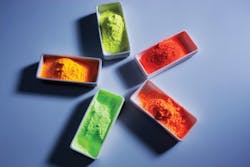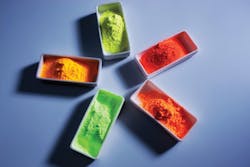MAURY WRIGHT interviews Intematix executive JULIAN CAREY on the state of intellectual property in the phosphor area, Intematix’s latest developments and patents, and applications from LEDs to backlighting to remote optics.
Phosphor remains one of the least understood business/technology angles of white, high-power LEDs and solid-state lighting (SSL); the state of intellectual property (IP) in phosphors is equally confusing. Indeed, many companies hold IP that directly addresses phosphor formulations and how they are applied and many more patents are tangentially related. The phosphor IP trail is often hidden among LED manufacturers by cross-licensing agreements. Still, the SSL industry needs a better understanding of phosphor patent rights and how patents may or may not impact product development and usage.
Back in mid 2012, we ran an IP-centric article specifically on remote-phosphor patents and IP holdings. The authors at IP Checkups identified Intematix and Cree as holding major IP stakes in the area. Since Intematix also supplies phosphors to LED manufacturers we took the opportunity to question Julian Carey, senior director of marketing, on the state of the phosphor IP space.
LEDs Magazine: Can you give us a quick foundation as to the history of phosphor-oriented patents that are both directly focused on LED products and perhaps that are more general in nature if there is an impact on SSL?
Julian Carey: High-brightness LEDs were originally developed around the 1990s by early producers of gallium nitride (GaN)-based blue LEDs in Japan after researchers from Nichia and a professor from Nagoya University shared their formulation. The combination of blue LED chips with YAG (yttrium aluminum garnet) phosphor was patented by Nichia in 1996 via US patent No. 5,998,925, commonly called the 925 patent.
As market research firm Yole Développement points out, while LED phosphor IP is complex and rich with thousands of patent families, only a few patents have provided significant returns to their owners in terms of market share, freedom of exploitation, or additional revenue streams from royalties. Some of those patents are on the verge of expiring within the next 5 to 10 years — most notably, Nichia’s 925 patent, which is set to expire in 2017.
LEDs Magazine: Intematix announced its green GAL (green aluminate) phosphor back in 2010 and touted it as an alternative to YAG and other licensed phosphor formulations. Indeed, at the time the company specifically said that its customers — and we assume that means customers making phosphor-converted LEDs or remote-phosphor SSL products — would not require licenses to Nichia or Osram phosphor patents. Have you developed a customer base for those patents among LED manufacturers or has the primary usage been in remote phosphor applications?
Carey: Today, Intematix is one phosphor maker that is further addressing the trend toward high-quality light with its patented, advanced phosphor technology. In addition to being the only company that makes the patented GAL formulation, Intematix patents also cover different wide-spectrum green phosphors called LuAGs (for lutetium-aluminum-garnet). GAL generally offers a broader spectrum, higher thermal stability, higher CRI, and higher quality of light compared to LuAG formulations, but owning IP that covers both GAL and various LuAG formulations enables Intematix to offer the more extensive portfolio of broad greens and reds essential to high-quality LED light.
Since the product introduction, GAL has seen widespread implementation in LEDs worldwide, which are its primary usage. The performance of the material in terms of its ability to reach high CRI, especially in combination with red, and its thermal stability has driven adoption. These same characteristics make it valuable in remote solutions as well.
LEDs Magazine: What has driven new phosphor developments beyond IP issues? Have the needs for better color quality and better color consistency over time been a driving factor? What about lower costs?
Carey: Growth in LED-based lighting in North America is estimated to average 38% annually between 2012 and 2016, according to a recent McKinsey & Company report. Now that we are seeing LED use transition into general lighting, thanks to reduced pricing and accessibility of products with LED technology, quality of light has become the predominant requirement. This, in turn, has led to a demand for more advanced phosphor solutions and a much more complex mixing strategy. Generally, a two- or even three-phosphor strategy is needed to attain high CRI and high R9, an indication of how well the light shows deep, saturated shades of red.
In addition to mixing strategy, phosphor solutions for general lighting require a high degree of ruggedness. They are based on very tough molecular structures and are lasting for upwards of 50,000 hours. Thus, today’s primary lighting phosphor options are green aluminate (such as GAL), red nitride, and YAG. Not only do these materials have long lifetimes, but they also have high thermal stability, independent of lifetime. For example, if you go as high as 200°C with GAL, you will only lose a very small degree of brightness — this very high degree of stability means that manufacturers can drive their LEDs harder and realize lower costs using fewer LEDs.
LEDs Magazine: While this isn’t a patent question exactly, a few years back there was great concern over the availability of rare earth materials needed for phosphors and the possibility that China would limit export of those elements. We have heard little about the problem of late. Has that situation stabilized? Did the development of new formulations help in anyway to avoid a shortage?
Carey: Base materials of most phosphors are very plentiful, but they have additives or dopants, and those are where you find these rare earth materials. So while the amount of rare earth materials in each of these phosphors varies, it’s usually very small, but it can be more significant in some. Despite some of the news clippings that have appeared over the last few years, we have not seen any effect of rare earth pricing or instability in the LED market overall. And the reason for that is two-fold. First, the amount of phosphor generally used in LED applications as a fraction of the lumens produced is very small. It just doesn’t contribute that much to the overall solution cost. That’s in contrast with fluorescent. Fluorescents have multiple grams of phosphors in each product, and there are also different formulations in those tubes. Some of the increase in pricing from China that we saw a few years ago actually did affect the fluorescent market. The second major reason is even though there was instability triggered by China’s actions, now we’re seeing additional sources pop up all over the world. Since it’s really not a monopoly anymore, we’re seeing a much more balanced market for these raw materials.
Generally, the improvements in LED technology, phosphor technology, in addition to the semiconductor technology, the driver electronics technology, all of that is going to far outrun any issues that we are going to see in rare earth supply.
LEDs Magazine: Intematix just announced the award of a new red nitride patent back in December and another covering similar technology back in September 2012. What technology is covered by those patents, and is that technology already being deployed in packaged LEDs and/or remote-phosphor optics? Has there been more recent innovation in green phosphors after GAL?
Carey: Red nitride phosphors play a central role in extending the color range of LED applications like general lighting and displays including TVs, monitors, and tablets. Intematix red nitrides combined with GAL green phosphors, phosphor combinations covered by the company’s previously issued patents, enable near-perfect color rendering up to 98 CRI. The XR red nitride also leads in color stability with less than perceptible 2-MacAdam-ellipse measured color shift in accelerated aging testing. This performance results in lighting applications with long-term color quality and consistency.
LEDs Magazine: We understand, as you said, that some of the most basic patents in the phosphor area will expire in the coming years. As we discussed, the Nichia 925 patent will expire. How will such an event impact the phosphor industry? Most of the major LED manufacturers have cross-licensing deals in place so it seems the impact there might be minimal. But could it shake up the industry in other ways?
Carey: The expiration of the Nichia patent will remove a significant barrier and will allow broader use of the YAG materials covered by the patent. Patent activity remains strong and it is now focused on emerging compositions, mostly addressing the need for more efficient and cost-effective red and green phosphors to be used in display and general lighting applications. Differentiation opportunities remain, and the development of any new compositions with disruptive potential could still greatly benefit its inventor.
LEDs Magazine: In the area of remote phosphor there have been continuing questions as to whether your customers making SSL products with your ChromaLit optics might need license agreements with other companies. Cree in particular has said that any company making remote phosphor lamps or luminaires needs to have a cross-licensing agreement in place. You have insisted that’s not the case. What is your stance and how are you standing behind your customers?
Carey: Intematix is very confident regarding its remote phosphor IP and stands behinds its remote phosphor products. In fact, not only will Intematix cover legal costs in the event of an infringement litigation regarding its products, but it will also take responsibility for the defense of any such litigation.
LEDs Magazine: Also with regard to remote phosphor, your latest products in the linear application segment have a coating that allows the products to appear white in the off state and therefore potentially appeal more to lighting designers/specifiers. What is the IP behind that technology? Is that a phosphor story or one based on yet another type of materials? Do you expect to patent that technology?
Carey: While we do have patents covering linear remote phosphor, the IP pertaining to the off-state appearance of our new linear product would fall more into the trade secret area. The way the technology conditions the light going into the optic differs from that exiting, which is why it shows good appearance without affecting light output too much. Different types of innovations may be best served in our business with different IP strategies and these are matters we consider to great extent.








